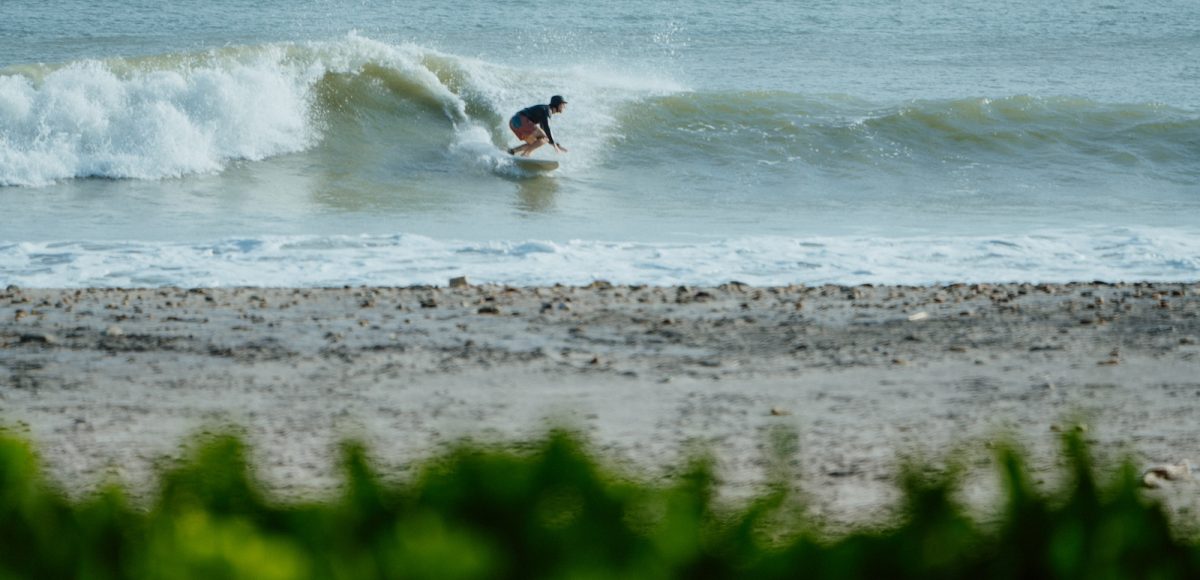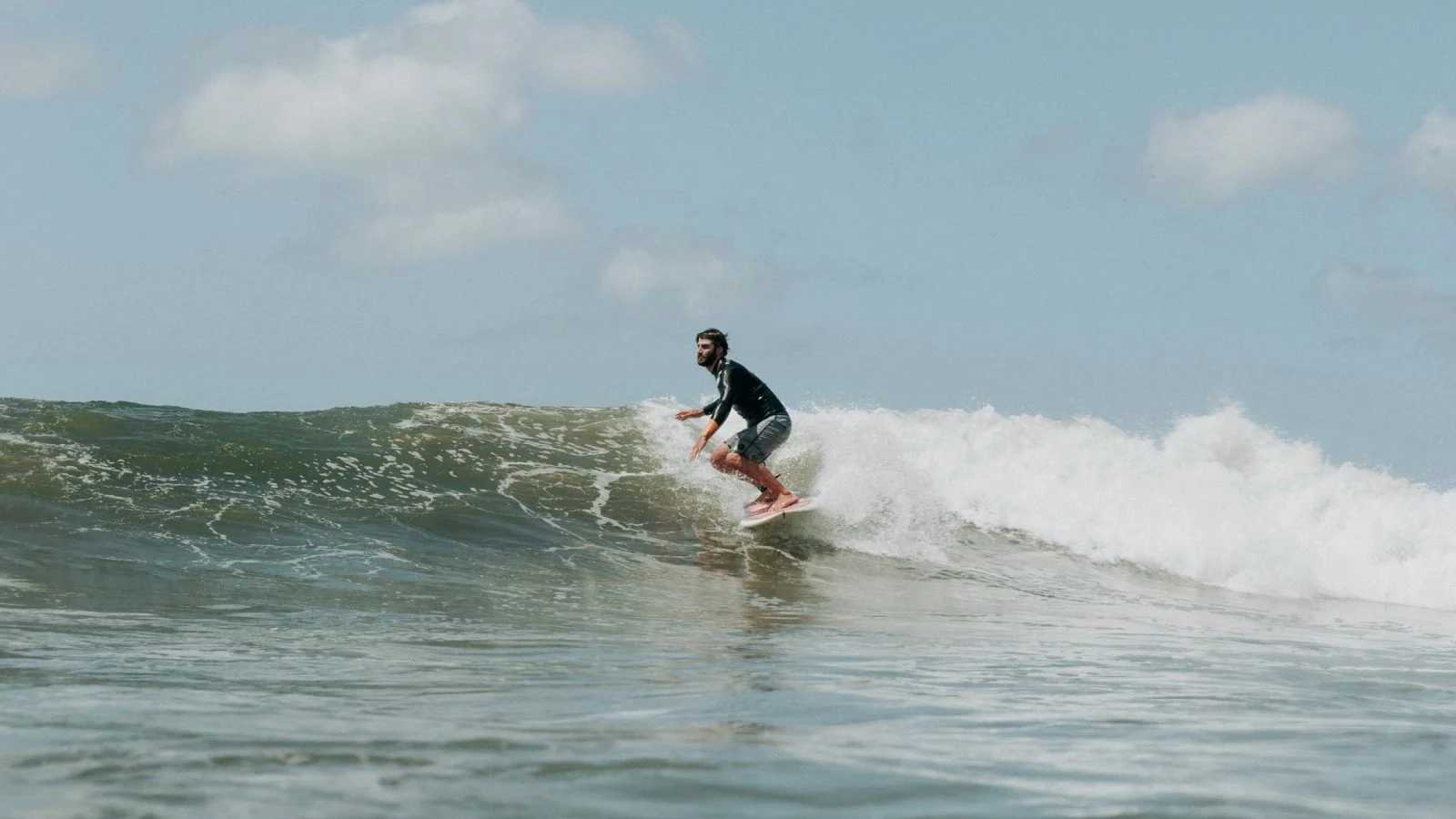Surfing is both an exciting and demanding activity that requires a combination of physical and mental skills. Learning to surf can seem daunting for some, but with the right approach and mindset, anyone can improve pretty quickly.
First and foremost, it’s important to understand that learning to surf takes time, dedication and practice. We think it’s one of the most difficult sports to get really good at and even for the top pro surfers, they will never consider themselves true masters of the ocean.
You are always at the mercy of Mother Nature when out in the waves – and just when you think you have it dialed, she will slap you back to reality.
You’re not going to become a ripper overnight, but with consistent effort, it is possible to make significant progress in a short amount of time.
One of the most important things you can do to improve quickly is to surf as often as possible. The more time you spend in the water, the more comfortable and confident you will become on your board and out in the lineup.
Another key factor in improving your surfing skills is to focus on the fundamentals. This means mastering the basics of paddling, popping up, and riding waves.
Once you have these foundational skills down, you can start to work on more advanced maneuvers like cutbacks, little floaters, and re-entries.
With these basic tips in mind, let’s dive into some specific strategies for getting good at surfing fast.
Understanding the Basics of Surfing
Surfing Equipment
To get started with surfing, we need to have the right equipment. The essential surfing gear includes a surfboard, leash, maybe some wax, and a wetsuit if you are surfing in cooler water.
Your surfboard should be chosen based on your skill level, height, and weight. A longer and wider board is suitable for beginners and as a basic rule of thumb we tend to go by these basics:
- Small adult > 7ft funboard or mini-mal
- Regular-sized adult > 8ft funboard or mini-mal
- Large adult > 9ft funboard or mini-mal
You’re also going to need a leash that attaches the surfboard to your ankle, preventing it from drifting away – either after you fall, or after a wave bashes you off the board when you are paddling (and yes, this happens a lot when you are just starting out).
Surf wax is applied to the deck of the surfboard to provide traction and prevent slipping – another vital part of the surfing experience that has lasted for decades.
Wave Knowledge
Surfing is all about catching waves, and to do that, we need to understand the ocean and its different moods and nuances.
Learn to read the waves, identify the best ones, and position yourself correctly to catch them – very easy to say in one sentence, but this alone takes quite a bit of practice.
The most difficult part is dialing in your positioning relative to the breaking wave. Of course, the wave is moving toward shore, so you need to anticipate where it will break, and where you need to be to catch it, all the while staying out of the way of other surfers who might also be in the lineup.
Safety Measures
Surfing can be dangerous, and we need to take some safety measures to avoid accidents and injuries. When you’re starting out always surf at spots relevant to your ability, try to avoid crowded spots, and respect other surfers’ space.
You should also be aware of some hazards of the ocean, such as rip currents, rocks, and topical reefs if you are in places like Indonesia or Costa Rica.
And it goes without saying you need to have a basic level of competence when it comes to swimming, holding your breath, and overall fitness.
When you’re starting out you will undoubtedly spend time underwater so try to get good at keeping calm in these situations – when on land, learn to hold your breath. Then when you do find yourself getting hammered by the waves, you can remain calm and go through the motions until you get back on your board and out into the lineup.
Developing Your Core Surfing Skills
To become a good surfer, it is essential to develop core surfing skills. These skills include paddling, standing up on the board, and other wave-riding fundamentals.
Paddling Techniques
Paddling is the foundation of surfing. Without proper paddling technique, it’s near impossible to catch waves and progress in surfing. Learn to paddle better, catch more waves, and get better at surfing – it’s a virtuous circle that will really move the needle.
To improve your paddling, focus on the following:
- Position yourself correctly on the board – there is a sweet spot you need to find
- Use your arms and shoulders to paddle efficiently – lift your head and arch your back
- Use your core to stabilize your body, and try to move smoothly and calmly – you don’t want to waste any unnecessary body movement
Practicing paddling in flat water will help you build strength and endurance, which will translate into better performance in the waves. Another great way to improve your paddle power is by swimming or using a tool like this surf trainer that you can use at home to boost your fitness.
Standing Up on the Board
Standing up on the board or ‘popping up’ is the next step after catching a wave. Just like paddling, this takes a lot of practice and there are some ‘on land’ exercises you can do to improve more quickly.
To initiate your popup, follow these steps:
- When you feel the wave pushing you forward, paddle a few extra strokes to gain speed.
- Place your hands on the deck of the board and push your upper body up.
- Bring your front foot forward and plant it on the board.
- Stand up bringing your back foot onto the deck of the board too.
You need to avoid going onto your knees – this is just a bad habit that you will want to avoid. As weird as it looks, you can practice your popup on land, on a board or without, just to get your muscles to learn the movement.
In the heat of the moment you just want to get to your feet without thinking about it – and the more you can repeat this action, the quicker you will progress with your surfing.
Wave Riding Fundamentals
Once you can paddle and stand up on the board, it’s time to focus on wave-riding fundamentals. Whether you are on a surf trip, or practicing at your home break, these remain the same and include:
- Reading the waves to find the best section to ride
- Generating speed by pumping your board
- Carving by shifting your weight and staying in the ‘pocket’ of the wave
Ideally, you want to practice surfing in small, mellow waves. This will help you build confidence and catch a lot of waves. When the waves are big you tend to spend a lot of time paddling, duckdiving, and trying to get into position. When the waves are smaller, you can get into position much more easily, and progress faster.
Improving Balance and Coordination
Balance Exercises
Improving your balance is key to becoming a good surfer. There are many exercises you can do to improve your balance, such as basic squats, standing on one leg or using a balance board.
These exercises help strengthen the muscles you use when surfing and improve your overall balance.
One simple exercise you can do is to stand on one leg for 30 seconds, then switch to the other leg.
You can do this while brushing your teeth or waiting in line at the grocery store. Another great exercise is to use a balance board, which simulates the movement of a surfboard on the water.
Start by standing on the board with your feet shoulder-width apart, then try to balance on the board for as long as possible. As you improve, you can try doing squats or other exercises on the board to challenge yourself even more.
Surf Fitness and Conditioning
Strength Training
Incorporating strength training into your fitness routine can help you improve your surfing performance.
It can help you build muscle mass, increase your power, and also help to prevent injuries. Some exercises that can help you improve your strength for surfing include squats, deadlifts, lunges, and push-ups. We recommend that you work with a personal trainer to develop a strength training program that is tailored to your specific needs, but if you don’t have access to this, there are a tonne of great workouts for surfing on Youtube.
Endurance Workouts
Endurance workouts can help you build your stamina and endurance for surfing.
These workouts include running, swimming, cycling, or any other form of cardio exercise.
We recommend that you focus on high-intensity interval training (HIIT) to help improve your endurance for surfing. HIIT involves short bursts of high-intensity exercise followed by periods of rest.
This type of training is perfectly aligned with surfing. Oftentimes paddling out to the waves is a long slow burn, and then when you need to catch a wave you need that explosive power to get into it.
And if you can maintain your fitness and not have to ‘get fit’ for your surf sessions, you will be in a much better place in the long run.
Flexibility Routines
Flexibility is an essential component of surfing, and surfing well.
To improve your flexibility, you should incorporate stretching and mobility exercises into your fitness routine. Yoga is an excellent way to improve your flexibility and balance – It can help you develop core strength, increase your range of motion, and improve your overall body awareness – which is vital when you are learning to surf, or trying to get better at surfing.
We recommend that you attend a yoga class or work with a yoga instructor to develop a yoga routine that is tailored to surf-specific movement, but to be honest, just doing yoga regularly will help you immensely.
In-Water Practice
When it comes to getting good at surfing fast, in-water practice is essential. Here are some tips to help you make the most of your time in the water.
Frequency of Sessions
Consistency is key when it comes to improving your skills. We recommend aiming for at least two to three sessions per week (ideally more) depending on your schedule and the conditions. This will allow you to build muscle memory and progress more quickly.
Choosing the Right Spots
Not all waves are created equal, and choosing the right spot can make a big difference in your progress. Look at surf spots that match your skill level and have waves that are appropriate for your abilities.
It’s also important to consider factors such as the crowd, the tide, and the wind direction. As corny as it sounds, some heavy reef breaks, or pointbreaks simply aren’t suited to ‘leaner surfers’ so be mindful of your ability and don’t go too far out of you comfort zone.
Try to go on as many surf trips as you can, and where possible surf the best waves you can find.
Learning from Mistakes
Making mistakes is a natural part of the learning process, and it’s important to embrace them as opportunities for growth.
Take note of what went wrong and try to identify specific areas where you can improve. You can also ask for feedback from more experienced surfers or consider taking a lesson to get personalized guidance.
A great tip that is pretty easy to set up these days, is to get someone to film you from the beach – you will be amazed at how different you look on camera to how you think you might look!
But in all seriousness, being able to see your body movements and positioning from land will help you to improve more quickly – conversely, if you don’t know what you are doing wrong in the first place, it’s hard to ‘fix’ a particular issue you might have with your pop-up, cutback or some other movement.
Learning from Others
Another super effective way to get better at surfing quickly is to learn from others who have more experience. In this section, we will discuss three ways to learn from others: surf lessons, watching professional surfers, and joining a surf community.
Surf Lessons
Taking surf lessons is one of the most obvious and popular ways to learn how to surf quickly. Surf schools offer beginner-friendly lessons that cover everything from equipment selection to proper technique.
Instructors can provide immediate feedback and help you correct mistakes, which can save you a lot of time and frustration. Additionally, surf schools often have access to the best beginner waves, which can make the learning process more enjoyable and a lot quicker than if you went it alone.
Watching Great Surfers
Watching pro surfers (or just really good surfers) can be an excellent way to learn how to surf better.
By observing their technique, you can gain insight into proper body positioning, wave selection, and timing.
You can also learn about different types of waves and how to read them. If you really want to get into the weeds and progress, there are a tonne of resources online – Watching surf contests or videos can be a great way to study the pros and learn from their experience.
Joining a Surf Community
Joining a surf community or a local surf club can be a great way to learn from others who share your passion for surfing.
Depending on where you are in your journey, getting involved in your local surf club is a great way to get some golden nuggets from experienced surfers willing to share their secrets.
Most clubs have events throughout the year on land too – the social component of being a surfer can’t be understated. If you do go down this route, it will help your surfing no end.
From learning about the local conditions from guys and gals who have been surfing for decades, to sharing a beer after a great day at the beach, it’s really these connections to other humans that make surfing so special.
Mental Preparation
Overcoming Fear
When it comes to surfing, fear can be a major obstacle for beginners – especially when the waves start to get big.
One helpful tip is to try and catch any wave as soon as you get out into the water – if you fall, no worries – this idea is to get you to catch a wave, and realize it’s not that scary. The most likely scenario is that if you fall, you’ll survive with everything intact. Tell yourself, “It’s ok, I’m still alive” and move on from there.
You’ll be amazed how well this actually works – more often the fear is all in our head, and the reality is nowhere near as bad as we think.
Another effective technique for overcoming fear is visualization.
Before hitting the waves, take a few moments to visualize yourself successfully riding the waves and feeling confident. Some pro surfers use the technique at a high-performance level, and the science behind it is interesting.
If you can get yourself into this headspace, apparently the thought of performing specific maneuvers is as effective as practicing it in the real World.
So give it a try and see how you get on.
To Sum Up
Getting good at surfing quickly is difficult, but with these strategies outlined in the piece it is possible.
Getting a lot of practice time in the water, maintaining and optimizing your body for surfing through workouts and mindfulness as well as a solid stretching regime will put you on the right path to success.
Just be sure that nobody ever masters surfing entirely – even the guys and gals who are considered the best in the World. Oh, and another word of warning – learning to surf is addictive, and once you get on this path, maybe your whole life will start revolving around swells, surf trips, and new surfboards.
You have been warned!




